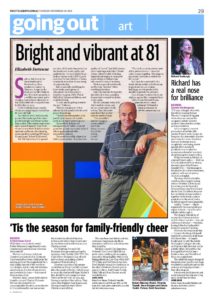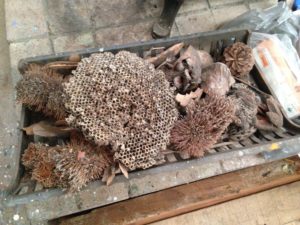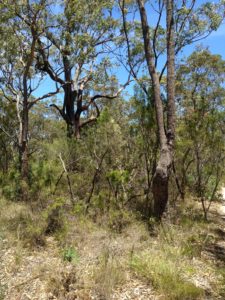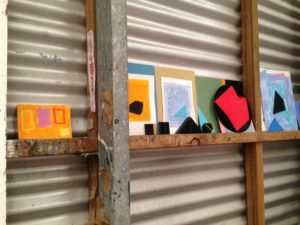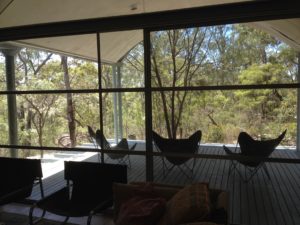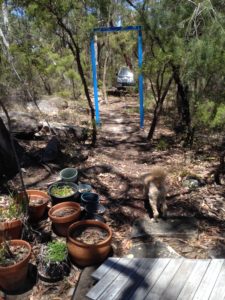Posts tagged Sullivan and Strumpf

Visiting Sydney Ball’s bushland retreat
Jan 1st
Posted by Elizabeth Fortescue in News
News that the late colour abstractionist Sydney Ball was to be represented in this year’s Sydney Biennale set me thinking about a boiling hot day in November, 2014, when I drove to Glenorie, a rural area 40km northwest of Sydney, to interview the grand old man of art. The interview was to be about Infinex III, Ball’s new show at Sullivan and Strumpf.
Cicadas were making a huge racket in the dry air as I opened the big swing gate to Ball’s property, its large notice declaring the place to be a wildlife sanctuary. Closing the gate behind me, I bumped my four wheel drive up the winding dirt roadway, seemingly into nowhere. But soon enough I came to Ball’s secluded home. It was utterly beautiful. Ball had bought this plot of land in 1976 with his then partner Lynne Eastaway. If they had wanted seclusion and privacy, they could not have chosen better. You simply couldn’t see any other houses. Native bushland sprouted everywhere from dry ground and between huge rocks.
Australian architect Glenn Murcutt designed the house for the couple, and they moved in on Christmas Eve, 1983. Ball’s studio was subsequently built within just a few steps of his front door. From about 1987, Ball told me, he had lived in the house alone.
Ball was a gentlemanly, quietly spoken man. Sadly he died in March 2017 at 83. You can read the Art Gallery of NSW’s tribute to him here.
After my idyllic trip to see Ball in his home, I wrote a story for the Daily Telegraph (reproduced below).
Here is the full transcript of our interview that day:
Elizabeth Fortescue: Why did you decide to live in this part of Sydney (Glenorie)?
Sydney Ball: The studio I was in at the time was on Broadway. It was owned by the Sydney City Council. They decided (to renovate). So I had to move from the studio and because it was one of the many studios I had to shift from I felt that was enough, I’m not going to get another studio and get the boot out of that. The city council offered me a beaut studio in Oxford St Darlinghurst and it proved a good space; access was a little difficult, up a flight of stairs, which makes it difficult for painters to move big stretchers around. But anyway at the same time I decided that I wanted to buy land, build a house and studios and that would be it, I’d stay there forever and ever. I went out and bought the paper and it had its real estate listed and I picked out one place that seemed pretty interesting. 25 acres of bush which they said could be easily cleared. I didn’t want to clear any bush; that for me is sacrosanct. At the time I hadn’t met Glenn Murcutt. We had a mutual friend who was a landscape architect; I met him in New York when I was having a show. He bought one of the first paintings that I’d sold. We became friends when he moved back to Sydney. I was living in Adelaide but we kept in contact. When I moved up here I met up with my friend again. I said are you interested in designing a house and he said no I’ve got too much work on. I said there’s an architect (who designed a house at Kempsey) and it turned out to be Glenn Murcutt and it was a beautiful space. It had what you required in a house. So for me this beautiful open space, which is just a nice feeling to live in. So my friend arranged a luncheon with Glenn and we discussed the situation and he said I’d be delighted to do it, but the work he had on at the moment would take him a couple of years at least and I said that was OK because it would take me two years to get the money together.
Ball said the house is very cool with wide door openings, adjustable louvres, blinds and good insulation. It had no air conditioning and Ball didn’t want any.
SB: I’ve got to sleep with a doona because it’s chilly at night and early morning. (The studios are not like that; when it’s too hot he comes back and does bookkeeping or housekeeping.) I wait until the ants leave a message on the floor!
I admired the Oceanic art objects that were on view all around the house, like the one in the picture below.
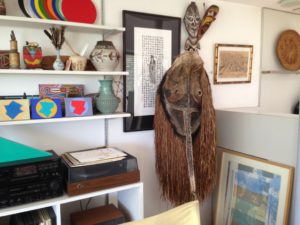
A snap I took of Sydney Ball’s home in Glenorie, showing some of the Oceanic items he so clearly prized.
SB: That came from very early days back in Adelaide. I was with Kym Bonython gallery. Kym used to import pieces from PNG and Africa. He made it an exciting place; not just showing one type of work, it was a whole mix of what the world consists of and other societies’ work of art. For me they’re tribal works of art. People call them “primitive” work. I really back up against that. They’re highly socialised works of art to represent the society that they live in; all the needs and things of that society.
EF: Did your art change when you came up here (to Glenorie)?
SB: Oh, it did, yes. I bought the land in 1976. Myself and my partner used to come up and camp up here. And we’d go around doing lots of drawing. It was a unique experience being in this type of landscape with all the marks and the symbolism of the bush and that whole drawing capacity of the trees interlocking with the branches and things like that. It was a lovely energy process that the environment had. I just felt it was something that I wanted to explore because I’d always been somebody living as an urban artist looking at something way out there but not being part of it. For me to be feeling that we’re right in it amongst it, and the changes that you realise are there which you haven’t experienced before are enormous. I mean, those little things that happen underfoot. All those little plants and mould that grows on dead trees. Just the whole exquisiteness of the environment. I thought there’s enough there. Because I work in series; I don’t want to just be tied down to one series throughout my whole life. I see it as a whole creative situation where you work through what you think is important to you at that particular in time. Once I feel I don’t want to go on any more from that point because I’m only going to repeat myself, I want to go to that next problem. But it’s what that next problem is. So along comes the landscape. Wow, you know, I’ve got enough there to warrant a whole range of series if I want. And the marvellous thing that one thing leads to another. Once you get into the bush, well OK, who are the other people that live in the bush? Indigenous people. Are they the only people that are here in the world that do that sort of thing? No, you have the people in China, in India, right through Asia doing the same thing, of working out signs and symbols and totems to explain what they’re about, what their society is. So one thing led to another. Because I’m living here I felt also that I wanted to bring back a figure into the landscape to tie up with indigenous people; the totems, the symbolism of totems. Who are the people that use these type of images to explain themselves in totem? So all the time it’s opening up the horizons of what is there, what is capable of being used in your sense as a painter.
In his studio, Ball had a big box of beautiful native things like a wasp’s nest, banksia and amazing seed pods. There was another basket of shells.
EF: What about bushfires? (It seemed to me that Ball was taking a major risk, what with bush growing wild right up to his house.)
SB: One came close. It was what I call a secondary fire. It started about 12 o’clock at night. That came off another major fire which was right at the back of the property but it came up the gully but didn’t come on to my side but the embers set up another fire as such on my side but a very low fire because it was starting to cool down and by the time it got to me it was a very low fire, burning bushes but not up into the trees but still pretty scary. While I’ve got tanks and sprinkler systems on the house it was during a season where there wasn’t much rain so the tanks were just about empty so my plan was to turn the sprinklers on when the fire really got close. At that time when I was ready to do it the electricity went off and I couldn’t use the pumps. But at the time the “fireys”(bushfire fighters) were moving down each property, house by house. It didn’t take much just to protect the whole area.
EF: When was that?
SB: That would have been 2002.
Ball said the whole property was “a field of flannel flowers” after the fire went through.
EF: You have had exhibitions of the present Infinex series already. When did that series begin?
SB: That started at the end of 2009, 2010. I started to plan for the extension of what I was doing. It was that thinking of putting down little notes and little thumbnail sketches. I have a book where if I’m sitting down watching telly, I can doodle along in a sense. I’m always intrigued by Frank Ghery, the Canadian American architect, his way of working where he’ll crumple up a paper and from that it comes out, the idea, you know? Wow there’s something in that particular shape that I can use. And it grows.
EF: Is that how this series began?
SB: Pretty much so, and through the thinking of Frank Ghery. I see what’s important in his work, how he brings in shapes that while not fully realised at that stage start to develop after a number of those shapes come together. There’s that growth of shapes which come together; a synopsis of shapes which all come together in the end to become a holistic building.
EF: I can see that in your wall works.
SB: Yes. While complete in themselves as that particular shape, they start to take on the importance once it comes to the next one and the next one, and start to build up this whole synopsis.
EF: I read that you don’t fiddle about with colour. Your use of colour is instinctive and intuitive.
SB: I guess I have the ability to know what I want before I begin. Occasionally I’ve got to change a colour, which I don’t like doing, because it’s just the wrong colour. But I’ll go into work knowing how I’m going to plan not only the shape but the whole of the painting with colour. That in the end is the most important part of the picture for me. How the colour comes together. The shape is important, but that’s a vehicle for the colour.
EF: Colour has been vital to you all your career?
SB: Oh yes, since I was in New York as a student. I guess it was seeing the great paintings of both the European artists and some of the great American painters at the time. It suddenly grew on me that that’s what I wanted to explore. That was, for me, just the natural part. I just had that natural ability to concentrate just on colour; not worry too much about the shape. If it was going to be one whole area of canvas in red, that was what it was going to be. That’s what I wanted out of painting at the time. But that grew over time as well. Going to Europe on one of those study leave programs, seeing that whole array of great colourists.
EF: Were you influenced by Mark Rothko (who Ball knew in New York)?
SB: Oh, yeah. This beautiful relationship of colour. The subtlety. The sublime of the colour which a lot of New York artists were searching for at the time. For me, Rothko and Barnett Newman were the two great colourists of New York at the time. What also was there which I saw as a student at the Museum of Modern Art was the Matisse Red Studio where the whole (inaudible on tape) painting of colour came into existence. That for me was a revolution; it was different from Cubism. Because you don’t see these things in magazines. You tend to lose touch with the artist, the subtlety of the paintwork. Standing in front of the Matisse Red Studio you could see it was a very loose handling of the colour. It was one of the great experiences at the time; everything you see in a photograph ain’t going to be true.
The guy that I studied with, Theodore Stamos, was very concerned with edging. How one colour reaches the edge, how it butts up to the next. (Hard, or blurred. Affects whole painting.) (Ball said, In his current series, he wanted to make a clear delineation between colours to create “speed” in the painting.) That’s what I like about Ghery’s work; you’ve got speed. A radiance. I like that.
EF: What about Pop art? Were you exposed to it?
SB: Yes. Like a lot of forms of art, Elizabeth, it’s difficult to say ‘this went to that point and finished and this thing took over’. There were artists like Rauschenberg and Johns who weren’t really in the Warhol mode but had sort of moments of it.
EF: What did you think of Pop art?
SB: I didn’t like it; I thought it was fairly slight. But it takes time to sort out these things, and there’s much stronger moments for it now. Artists who gave their soul to what they did. Some people like it, some won’t.
Ball said one of the great exhibitions was at the Metropolitan Museum of Art in 1970, featuring David Smith sculpture, several Hans Hoffmans, and Jackson Pollocks, all in the one room.
SB: Too much for the brain to take in. Following that you had the next room of Rothkos, de Koonings, Barnett Newman. And so it went on right through the whole Metropolitan, virtually. But what the artists including myself thought was, ‘wow, abstract expressionism is not completely dead’. But it didn’t want to repeat what had gone on. It was time to bring in different processes. It was time to bring in enamel (and other new materials). It was termed by Aldrich ‘lyrical abstraction’, which is a terrible term. He (Aldrich) opened a museum in Connecticut. They bought one of my Cantos.
EF: Chuck Close. He’s seven years younger than you? Were you aware of him in New York?
SB: Yes, I’d seen Close’s exhibition.
EF: Did you meet some of these artists? What about Rothko? He was a lot older than you.
SB: Oh yeah, I knew Rothko. I had Thanksgiving dinner with him. I was in his studio and this is during my first trip as a student because the guy I was studying with, Theodore Stamos, he knew that I was living off rice and Puerto Rican kidney beans. So he got me some odd jobs because I wasn’t allowed to take a full job because of the immigration problem. You had to do a morning or afternoon class. So I did printmaking lithography in the morning, had the afternoon free, and then came back to the Art Students League in the evening to paint in Stamos’ class. He teed up some part time odd job work in Rothko’s studio. Just shifting stretchers around and helping other people hold things and all that sort of business.
EF: What was your impression of Rothko?
SB: I always feel the artists I met there, the major ones, so to speak, their work reflected the person. I remember meeting de Kooning in his studio down at Long Island with Stamos again, it’s the enthusiasm of the person. Jumping around, getting enthusiasm. He was finishing off his building at the time. One of the things he was excited about when I met him was he had these sliding doors but they weren’t in place at the time, and he’d painted a woman series on them. And he was so ecstatic because they had handles on the side that he could pick these up and carry them around. The whole floor was littered with drawings and that. I said to Stamos, ‘gee I would have loved to get one of those drawings’. He said, ‘you should have asked, he would have given you one’.
With Rothko it was the same .Very deep, you know? There wasn’t the outgoing-ness as such. But incredibly erudite. He reflected his work in a sense. In a way I can see that sense of working out a Greek tragedy; that tragedy was going to happen at some time, I think.
EF: Rothko had a tragic life?
SB: He had a very difficult life where he emigrated from Russia with the family.
EF: Did you meet Chuck Close?
SB: No, they were a different element to what I was interested in at the time. I kept mainly to the area I was consumed with, the colourists. Even with the lyrical abstractions were still using colour quite prolifically. That’s where the stains paintings came from, that whole second period of lyrical abstraction.
EF: It’s interesting to think of you being in that lineage of Rothko and de Kooning.
SB: It was being in New York at the right time, believe me. There hadn’t been very many Australian artists. And the Americans always wondered, who is this guy? He’s got a different dialect from us. Some would say, you speak very good English, don’t you?
EF: Were de Kooning and Rothko interested?
SB: They were inquisitive. I kept my mouth shut and my ears open. (At the Thanksgiving lunch at Rothko’s home, Ball met Rothko’s wife and children, one of whom was a baby. They said ‘Australia’s about the same time as Texas, isn’t it?’.) I was going to say it’s a bit bigger than Texas, mate!
EF: Your exhibition includes for the first time some works that are meant to be displayed outside?
SB: It’s about taking it to that next stage. Instead of using acrylic paint, what if I used spraying enamel that motor vehicle people use to spray their cars with. It’s durable and has a beautiful depth of colour to it. ( He outsources the spraying.) The opportunity exists for this type of material to be shown outside. What I do in the way of scale can be easily increased from that one panel. And people would like to show smaller works outside on the patio. You’re not restricted to having it inside.
EF: Change is important to you?
SB: Patrick McCaughey a dear friend of mine says I could have been the Josef Albers of the Antipodes because of the Cantos. I could have stayed with them because they started to make a hell of a lot of money for me, believe me. But I didn’t, I went into the Persian series. It was a similar process but it was to do with Islamic architecture. But it was a good point to make. That’s how I feel with every series. With the Cantos, I’m sorry in a sense that I didn’t paint some very large works to envelope the viewer. The AGNSW has just bought one of the big stain paintings which is 20’ wide by 9’. For me it’s the scale which envelops the viewer; that whole nebula of colour, the ocean of colour, which just soaks you in. (Wayne Tunnicliffe bought it for the AGNSW.)
EF: Why Infinex as a series name?
SB: Just the infinity. The idea I can either keep on doing these (laughter), or change.
EF: Is the series now over?
SB: Let me say it’s getting towards the end. But again I think, and there’s one piece in it that reflects what is possible for the next group of paintings. It’s a similar work but different. (Sprayed with lacquer.) I’m contemplating what to do (next). I just have to let it settle down in my mind before I go on.
So that was my visit to Sydney Ball’s place. There was a rectangular blue arch leading to the house from the front, which you can see in the picture at left. Ball told me it was the portal between fantasy and reality, and he wasn’t sure which was which. It didn’t really matter. Whatever Sydney Ball’s reality was, it was wonderful.
Posted by Elizabeth Fortescue, January 1, 2018, Sydney, Australia

